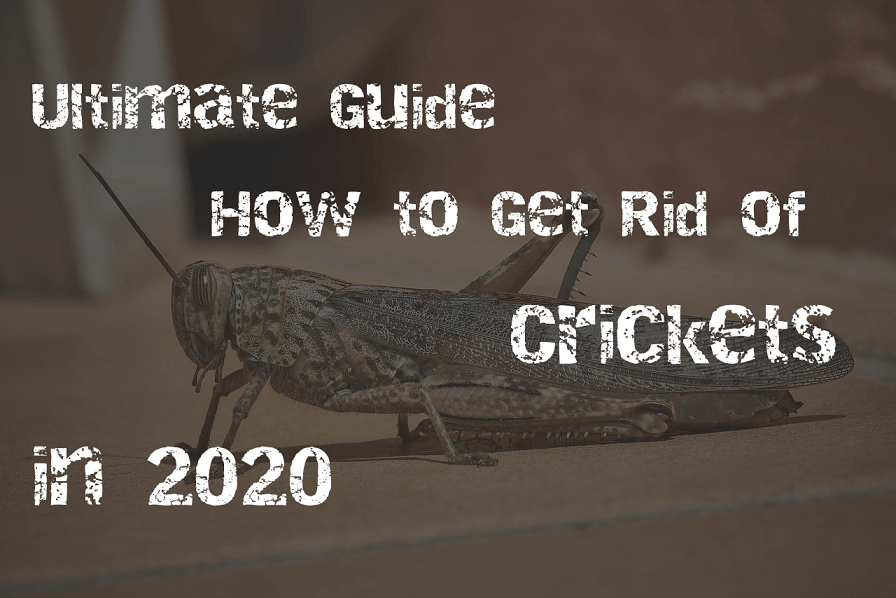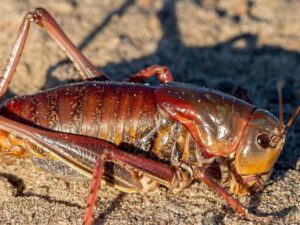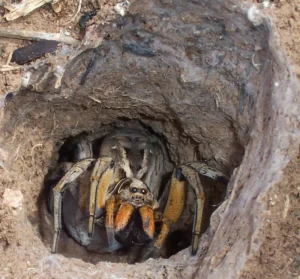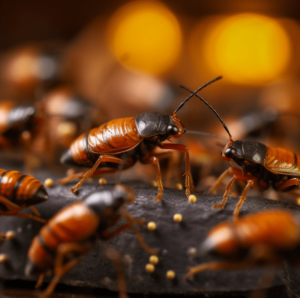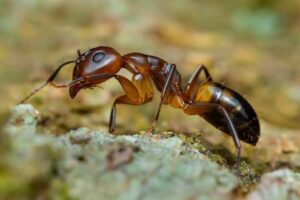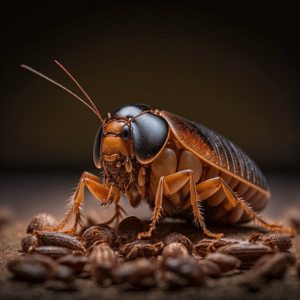If the chirping of crickets is causing you sleepless nights, it’s time to learn how to get rid of crickets. In small numbers, it’s easy to ignore the singing of these small insects, but in large numbers, they easily become an irritant. What’s more, if they reproduce in your house in large numbers, they can cause damage to paper products, clothing, furniture, and sometimes walls.
Effective Methods for Getting rid of Carpenter Bees in 2022
|
Editor’s Picks |
Brand |
|---|---|
|
Safest |
|
|
Best Natural |
|
|
Best Electronic |
|
|
Best for Indoors |
No products found.

Safest Technique: Diatomaceous Earth
Diatomaceous earth is a non-toxic powder that kills through touch and by ingestion. The powder contains microscopic, razor-sharp edges that cut into the cricket's exoskeleton and absorbs water from the body. In case the cricket ingests the absorbent powder, it quickly absorbs the insect's moisture, thus drying it out from the inside. The product works both indoors and outdoors and can easily get rid of all crawling insects within 48 hours of application. You simply sprinkle the non-staining powder on infested areas. Make sure you apply it in every crack and crevice where crickets may hide or travel through. If you are fed up with crickets chirping, it's time to get rid of these pests using this safe and eco-friendly product.

Most Natural: Harris Cricket Glue Traps (2-Pack)
If you have started staying awake due to cricket noise, the Harris Cricket Glue Traps are for you. These traps are easy to use and non-toxic making them safe for kids or pets. Among the best cricket traps on the market, this one is the easiest to use. You simply have to fold the trap and insert the tab at the top to hold it together. It is a versatile trap for crickets as you can use it on residential and commercial buildings. The trap is discreet and can easily slide in hard-to-reach areas where crickets hide. The package comes with two large traps included in each package. The traps are irresistible and lure the crickets making them highly effective in getting rid of these noisy pests. If you need a cheap, non-toxic, practical and versatile way to get rid of all types of crickets, this trap is your bests answer.

Best Electronic Repellent: MaxMoxie Ultrasonic Pest Repellent
This ultrasonic pest repeller ranks high among the digital techniques for fighting pests. It helps with the removal of a wide range of pests, including crickets, mice, mosquitoes, cockroaches, spiders, bedbugs, to mention but a few. The device works through ultrasounds which disorient and perturb crickets and other pests. This makes your home inhabitable and they also avoid encroaching it for food. This cricket repellent is 100% kid and pet safe. The sounds emitted by the pest repellent are safe to humans and pets. It is an eco-friendly alternative to toxic chemicals, poisons, and traps. They don't leave any mess behind as the crickets are repelled from nesting or feeding within your house. Compared to other ways to get rid of crickets, this is safer and simple to use. You only need to plug in the small-sized device into any outlet for it to start working. It can cover average-sized rooms such as kitchens, attics, basements, and garages. It doesn't consume a lot of electricity and saves you a lot of money compared to chemicals.

Best for Indoors: Wondercide Natural Indoor Pest Control Spray
If you hear cricket chirping inside your house, it's most likely you have the irritating house cricket. This nocturnal cricket species lives in fireplaces, kitchens, patios, behind appliances and furniture, and any crevices in your home. The Wondercide Natural Indoor Pest Control Spray is the perfect solution for these house crickets. It is both a preventative and a treatment product for getting rid of flies, moths, gnats, carpet beetles, earwigs, palmetto bugs, waterbugs, ants, spiders, roaches and bugs. It contains essential oils and you can choose from four flavors; Rosemary, lemongrass, cedar, and peppermint. You can use it on carpet and furniture to keep away crickets. The pet-friendly spray is safe to use around cricket hiding nooks. It contains no artificial colors, chemicals, fragrances or synthetic pesticides that can cause health issues in humans and pets.
Home Remedies for Removing Crickets
- Boric acid bait trap
- Drown the crickets with molasses
- Sealing cricket-entry points
- Remove the cricket eggs
Do-It-Yourself Solutions and Traps to Get rid of Crickets
Boric Acid Bait Trap
- Mix two cups of cornmeal with two teaspoons of boric acid
- place the bait where you have heard or seen crickets
Drown the Crickets with Molasses
- Use a large container or jar to Mix some molasses with water.
- Place container with the molasses solution near the cricket-infested area of the house.
- Crickets love the scent of molasses and they will drown in the solution
Sealing Cricket-Entry Points
Sealing crickets’ entry points is a natural solution to get rid of these pests. Look for any gaps or cracks along the wall and seal them using putty, caulk or other sealing materials. Seal your windows and doors. You can also use weather-stripping material to seal the gaps of doors and windows. This prevents entry of crickets into the house.
Remove the Cricket Eggs
Cricket eggs will hatch and exacerbate the infestation. For this reason, you should consider removing these eggs using a High-Efficiency Particulate Air (HEPA) filter vacuum cleaner.
The machine pulls eggs and other small particles from carpets and other hidden areas. Dispose of the vacuumed dirt away from the house. Spraying along trims of walls will also kill the eggs.
Interesting Facts about Crickets
- Crickets play a variety of songs, each with its unique purpose. For instance, there are males calling songs, courtship songs, songs to announce their partnership and rivalry music.
- They are named for the sounds they make. Criquet is an Old French word that refers to the cricket’s song.
- Most female crickets don’t sing as they lack the sound-making wing structures
- They produce sound by stridulating ( rubbing body parts together)
- Crickets have ears/auditory organs on front legs
- They have acute hearing due to the location of the ears
- Crickets are high in protein and calcium and are delicacies in parts of the world
- These insects are revered in China
- Cricket vs grasshopper: Crickets, grasshoppers, and locusts belong to the order Orthoptera. However, crickets differ from grasshoppers in various ways. They have longer antennae and also produce chirping noises. While a cricket’s ears are on the front legs, those of grasshoppers are on their abdomen.
How to Prevent Crickets
Before they become a menace in your home, use the following tricks to prevent cricket infestation:
- Seal cracks around your house
- Seal utility access holes
- Deny crickets shelter by tore firewood away from the home and clearing litter on your compound.
- Store trash away from your house
- Keep a cat in your house to repel crickets
- Use cricket baits with molasses mixture in containers to trap crickets
FAQ
What Kind Of Spray Will Help to Get rid of Crickets?
Any spray that contains essential oils such as thyme, rosemary or cloves will help repel and also kill crickets. Like other insects, crickets have a natural aversion to smell and this is why most insect sprays contain essential oils. Any spray with eugenol which is a derivative of clove oil is highly effective for killing crickets.
WHERE DO CRICKETS COME FROM?
Crickets belong to the family Gryllidae. They are versatile and can be found in diverse habitats. Some sub-families are found in bushes, upper tree canopies, in grasses and herbs, marshes, beaches, and caves.
Unlike brown crickets (house crickets) black crickets live in outside surroundings are meatier and larger and have a harder shell. They have spindlier legs and stay on the ground most of the time.
Some are subterranean and live in shallow or deep burrows.
The field cricket is larger than the house species, dark brown to gray or blackish and widely distributed over the United States where it thrives in outdoors feeding on soft plant parts.
WHAT DO CRICKETS EAT?
They are omnivores with a diverse diet that includes meats, fruits, and vegetables. They also feed on rotting leaves, rotting fruit, vegetables, and insects. Around homes, they scavenge on whatever they can find indoors and in the yard.
HOW LONG DO CRICKETS LIVE?
Crickets have a short lifespan of 8-10 weeks and then die of old age
DO CRICKETS BITE?
Yes, they can bite but their mouthparts can’t puncture the skin.
HOW DO CRICKETS CHIRP?
Crickets produce sound by rubbing their wings together. The lower cricket wing teeth-like ridges while the upper wing looks like a scraper. The two rub together to create a chirping sound called “stridulating.
HOW TO GET RID OF SPIDER CRICKETS
Keep them out of basements and crawlspaces by sealing them. Fix weather-strip openings at the lowest levels of these spaces. Declutter your home and dehumidify your living space and also use sticky traps.
HOW TO GET RID OF CAMEL CRICKETS?
Use a dehumidifier to make your home an inhospitable place, set sticky traps, use insecticides, drown them in containers of soapy water, or get a Siamese cat to hunt them.
CAN CRICKETS FLY?
Crickets might have wings but they can’t fly. They can, however, jump or travel short distances by producing jerky moves.
HOW TO KILL CRICKETS?
Use food-grade diatomaceous earth, drown the crickets with molasses mixture in containers, use vinegar in water (at 4 oz. per quart) or set sticky traps.

